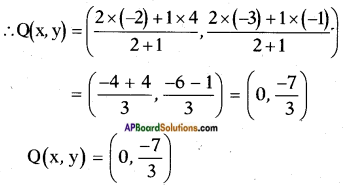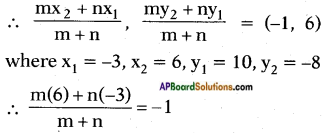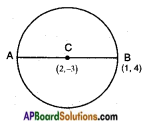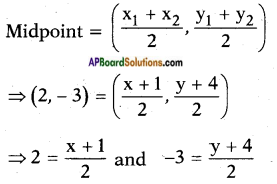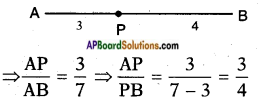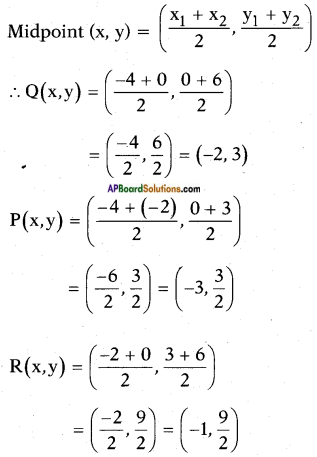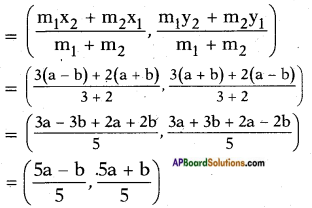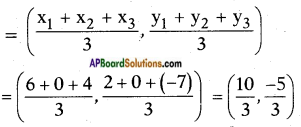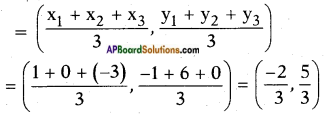AP State Board Syllabus AP SSC 10th Class Social Studies Important Questions Chapter 19 Emerging Political Trends 1977 to 2000.
AP State Syllabus SSC 10th Class Social Studies Important Questions 19th Lesson Emerging Political Trends 1977 to 2000
10th Class Social 19th Lesson Emerging Political Trends 1977 to 2000 1 Mark Important Questions and Answers
Question 1.
Expand the term AIADMK.
Answer:
All India Anna Dravida Munnetra Kazagam.
Question 2.
Give any two examples for Regional Political parties.
Answer:
TDP, YSRCP, JANA SENA, TRS, AIADMK, DMK, etc.
![]()
Question 3.
Which welfare schemes initiated by N.T. Rama Rao are still continuing with some changes in Andhra Pradesh?
Answer:
- Mid-day meal scheme in government schools.
- Sale of rice at subsidy rates to the poor.
Question 4.
Identify at least any two states presently ruled by regional parties in India on the given Indian political map.
Answer:

Question 5.
What was the contribution of Telecom revolution?
Answer:
The contribution of Telecom Revolution:
A network of telephonic communication in the country using satellite technology increased.
Question 6.
Mention any two initiations of N.T. Rama Rao.
Answer:
- Sale of rice at Rs. 2/- kg
- Mid day meal scheme in government schools.
- Liquor prohibition
![]()
Question 7.
Write about the 73rd amendment of the constitution.
Answer:
73rd amendment: The 73rd constitutional amendment created institutions of local self government at the village level and so Gram Panchayat, Mandal Parishad and Zilla Parishad are formed.
Observe the table given below and answer the questions 8 & 9.
Results of Telangana State Assembly and Parliament Elections – 2014
| S.No. | Name of the Party | Assembly Seats won | Parliament Seats won |
| 1. | T.R.S. | 63 | 11 |
| 2. | Congress Party | 21 | 2 |
| 3. | T.D.P. | 20 | 2 |
| 4. | Others | 15 | 2 |
| Total | 119 | 17 |
Question 8.
Name the two parties that secured more than 15 Assembly seats.
Answer:
Parties that secured more than 15 Assembly seats.
- TRS
- Congress Party
- T.D.P
Question 9.
Why did TRS secure more seats in 2014 elections?
Answer:
TRS secured more seats in 2014 elections because it played a key role in Telangana agitation.
Question 10.
What is meant by the Coalition government?
Answer:
During the time of General Election to the Assembly and Lok Sabha, no party gain the majority to form the government at the centre or state at that time. Two or more than two political parties come together to form a single government.
(OR)
A number of national and regional parties had to come together to form governments at the centre.
Question 11.
Name some non-political movements.
Answer:
Environmental movements, the feminist movement, civil liberties movement, literacy movements.
Question 12.
Which became powerful motors of social change?
Answer:
A number of non-political movements emerged and became powerful motors of social change.
Question 13.
Which parties decided to merge together and form the Janata Party?
Answer:
The Congress, Swatantra Party, Bharatiya Jan Sangh, the Bharatiya Lok Dal and the Socia¬list Party decided to merge together and form the Janata Party.
![]()
Question 14.
Who supported the Janata Party?
Answer:
The DMK, the SAD and the CPI (M) chose to maintain their separate identities but supported the Janata Party in a common front against the Congress.
Question 15.
Who played an important role in bringing together all the anti-Congress and anti-Emergency parties?
Answer:
Senior leaders like Jayaprakash Narayan and Acharya JB Kriplani played an important role in bringing together all the anti-Congress and anti-Emergency parties to fight the elections.
Question 16.
What was the argument of the Janata Party regarding the dismiss of nine state governments?
Answer:
The Janata Party argued that the Congress party had lost its mandate to rule in the States as it had been defeated.
Question 17.
Which created a bad state in A.P.?
Answer:
In Andhra Pradesh, the frequent change of Chief Ministers by the central Congress leadership and the imposition of leaders from above created a bad taste.
Question 18.
Who moved to Assom and Bengal?
Answer:
The Bangladeshis moved to Assom and Bengal.
Question 19.
Name some communities of Assom.
Answer:
Bodos, Khasis, Mizos and Karbis.
Question 20.
Who was Bhindtanwale and what was his demand?
Answer:
Bhindranwale, the leader of the group of militant Sikhs began to preach separatism and also demanded the formation of a Sikh State- Khalistan.
Question 21.
What did the militants try?
Answer:
The militants tried to impose an orthodox life code on all Sikhs and even non-Sikhs of Punjab.
![]()
Question 22.
Who made a declaration in April 1986?
Answer:
In April 1986, an assembly at the Akal Takht, made a declaration of an independent state of Khalistan.
Question 23.
Where were the militants engaged in?
Answer:
The militants were also engaged in large scale kidnapping and extortion to raise funds for their work.
Question 24.
How were the methods used by the govern¬ment for the suppression of militancy in Punjab?
Answer:
The Government used very harsh methods for the suppression of militancy in Punjab, many of which were seen as a violation of. Constitutional rights of citizens.
Question 25.
What did Rajiv Gandhi begin?
Answer:
Rajiv Gandhi began a peace initiative in Punjab, Assam and Mizoram and also in the neighbouring country of Sri Lanka.
Question 26.
What is called the telecom revolution?
Answer:
Rajiv Gandhi initiated what is called the ‘telecom revolution’ in India which speeded up and spread the network of telephonic communication in the country using satellite technology.
Question 27.
What had been under dispute for some time regarding Babri Masjid?
Answer:
Some sections of the Hindus had begun a campaign for building a temple for Lord Rama in Ayodhya in the place of Babri Masjid.
Question 28.
What is the speciality of Elections held in 1989?
Answer:
The issue of corruption in administration and in political circles became the main plank of the election campaign for non-Congress political forces in the next elections held in 1989.
Question 29.
What is Policy Paralysis?
Answer:
Policy Paralysis means the coalition could not implement any policy which called for serious change for fear of withdrawal of support by one or the other partners.
Question 30.
Which was the first coalition to be re-elected?
Answer:
The UPA was the first coalition to be re-elected.
Question 31.
Who led the Left Front Government in West Bengal in 1977?
Answer:
Jyoti Basu of CPM led the Left Front Government in West Bengal in 1977.
![]()
Question 32.
On what did the Operation Barga depend?
Answer:
Operation Barga depended heavily on collective action by the share croppers and Panchayati Raj Institutions thus avoiding bureaucratic delays and domination of the landowning classes.
10th Class Social 19th Lesson Emerging Political Trends 1977 to 2000 2 Marks Important Questions and Answers
Question 1.
Read the following paragraph and answer the questions.
The Government used very harsh methods for the suppression of militancy in Punjab, many of which were seen as a violation of the constitutional rights of citizens. Many observers felt that such violations of constitutional rights and human rights were justified.as the constitutional machinery was on the edge of collapse due to militant activity.
Express your views on the information given above.
Answer:
There was a threat to the integration of the Indian nation due to the militancy in Punjab. If the government had not taken such actions, the map of India would be different today. So I think the government was correct.
Question 2.
Read the given data to answer the questions.

A) Which were the parties that participated in the governments of the National Front and United Front and supported the government from the outside?
Answer:
To National Front: CPM, CPI, and BJP.
To United Front: CPM.
B) Mention the name of the party that participated in the above three governments.
Answer:
J.K.N.C.
![]()
Question 3.
Based on the information given below, answer the following questions.
| End of Emergency and formation of Janata party government under Morarji Desai and Charan Singh | 1977 |
| Formation of Congress government led by Indira Gandhi | 1980 |
| Formation of TDP | 1982 |
| Operation Blue Star and assassination of Indira Gandhi | 1984 |
| Rajiv Gandhi Accords with H.S. Longowal on Punjab and AASU on Assam. | 1985 |
a) Name the first non-Congress party which formed the government at the centre.
Answer:
Janata Party is the first non-Congress party which formed the government at the centre.
b) Who is the founder of Telugu Desam Party?
Answer:
Nandamuri Taraka Rama Rao (NTR) is the founder of Telugu Desam Party.
Question 4.
Which are the newest states of India, when they created?
Answer:
| State | Year of formation |
| 1. Uttaranchal / Uttarkhand | 2000 |
| 2. Jharkand | 2000 |
| 3. Chattisghar / Chattisghad | 2000 |
| 4. Telangana | 2014 |
Question 5.
Read the table and answer the given equations.
| Assassination of Rajiv Gandhi and government led by Congress party with P.V. Narsimha Rao as P.M. | 1991 |
| Economic liberalization | 1990 |
| Demolition of Babri Masjid | 1992 |
| National Front Government with Deve Gowda and I.K. Gujral as P.M.s | 1996 |
| NDA government led by A.B. Vajpayee | 1998 |
a) Which party won in 1996 elections and formed government?
Answer:
National Front.
b) Name the Coalition Governments mentioned in the above table.
Answer:
National Front and NDA Governments.
Question 6.
Write about people’s welfare schemes started by present Governments.
Answer:
- Supply of rice at the cost of Rs. 1 per Kg to the white ration cardholders.
- Pensions for the old age people and widows.
- Free textbooks, uniforms and Midday meal scheme in government schools.
- Housing schemes for the poor people.
- Health scheme for the poor people.
- Fees reimbursement to the poor for higher education, etc.
Question 7.
Read the following text and answer the questions given below.
The Congress returned to power in 1980. The Congress immediately paid back the Janatb in the same coin by dismissing the Janata and non-Congress governments in nine States. The Congress was victorious in all the States except Tamil Nadu and West Bengal.
A) Which party ruled before 1980s?
Answer:
Janata Party.
B) In which two states, the Congress party was defeated?
Answer:
Tamilnadu and West Bengal.
![]()
Question 8.
Prepare a table by classifying the given political parties into National and Regional Parties. “BJP, YSRCP, TDP, CPM, CPI, DMK, Congress-1, AGP”.
| National parties | Regional parties |
Answer:
| S.No. | National Parties | Regional Parties |
| 1. | Bharatiya janata Party | DMK |
| 2. | Congress -1 | TDP |
| 3. | CPI | AGP |
| 4. | CPM | YSRCP |
Question 9.
Based on the information given below, answer the following questions.
| Election and formation of Janata Dal government with VP Singh and Chandrasekhar | 1989 |
| Decision to implement Mandal Commission recommendation | 1989 |
| Ram Janmabhoomi Rath Yatra | 1990 |
| Assassination of Rajiv Gandhi and government led by Congress party with P.V. Narsimha Rao as P.M. | 1991 |
| Economic Liberalization | 1990 |
| Demolition of Babri Masjid | 1992 |
| National Front Government with Deve Gowda and IK Gujral as PMs | 1996 |
| NDA government led by AB Vajpayee | 1998 |
i) Who was the Prime Minister at the time of demolition of Babri Masjid?
Answer:
P.V. Narasimha Rao.
ii) Give two examples of the Coalition government.
Answer:
- Janata Dal government.
- National Front government.
- National Democratic Alliance (NDA).
Question 10.
Sometimes coalition governments cause ‘Policy Paralysis’. Do you agree with this statement?
Write your opinion.
Answer:
Yes. I agree with this statement. The coalition could not implement any policy which called for serious change for fear of withdrawal of support by one or the other partners.
Question 11.
“Coalition Governments cause political instability.” Comment.
Answer:
- Sometimes no single party wins a majority of seats to form a government of its own. In such the situation, a number of political parties come together and form coalition governments.
- A common agreement between these parties has to be arrived at, but this is not so easy.
- Different parties put pressure on the government for their different interests.
- The government cannot implement any policy for fear of withdrawal of support by one or the other partners. The governments become instable.
- This is called policy paralise which is frequent in the coalition government.
![]()
Question 12.
What are the situations that paved to strengthen the regional parties in present days?
Answer:
The situations that paved to strengthen the regional parties
- Regional aspirations – regional movements.
- Intermediate castes strengthening – gaining political power.
- To gain political power.
- Defections and corruption.
Question 13.
Write the main reasons for Assam movement.
Answer:
- Demand for autonomy.
- Protest against the domination of Bangladesh.
- Migration from Bangladesh.
- Fear of losing their cultural roots.
- Trade and other establishments were in the hands of outsiders.
- No preference in employment for locals.
Question 14.
Observe the following table and analyse it.
Table: Seat share of various Political parties in 2014 (lok Sabha)
| S.No. | Political patty | Won Seats |
| 1 | Bharatiya Janata Party (BJP) | 282 |
| 2 | Indian National Congress (INC) | 45 |
| 3 | Telugu Desam Party (TDP) | 16 |
| 4 | Telangana Rashtra Samithi (TRS) | 11 |
| 5 | Left parties [CPI + CPI (M)] | 10 |
Answer:
- In 2014 General elections BjP got with 282 seats and form the largest party and form the government also.
- Indian National Congress got only 45 seats.
- Left parties CPI + CPI (M) joined together got 10 seats.
- The Regional parties like TDP 16 seats 8i TRS 11 seats gained In Lok’Sabha elections.
Question 15.
What are the important changes that occured in India between 1975-85?
Answer:
Many changes occurred In India between 1975-85. Some of them are:
- Emergency was declared by smt. Indira Gandhi as she was asked to quit her Prime Minister post by Allahabad high court.
- Janatha Government came into power in 1979.
- Congress Party came to power in the elections after Janatha govt, failure.
- Non-political movements like environment movements, feminist movements, civil liberties movement and literacy movements came up.
Question 16.
At present, what is the necessity of coalition politics?
Answer:
In the present multiparty system in India it is impossible for any single party to win a majority of seats and form a government of its own but in 2019 elections BJP has won the election as single party. It went as coalition.
![]()
Question 17.
Read the following paragraph and comment on it.
In Andhra Pradesh, the frequent change of Chief Ministers by the central Congress leadership and the imposition of leaders from above created a bad taste. There was a feeling that the Andhra Pradesh leadership was not getting respect from the national Congress leadership. This was perceived as an insult to the pride of the Telugu people. N.T. Rama Rao(NTR), popular film actor, chose to take up this cause. He began the Telugu Desam Party (TDP) on his 60th birthday in 1982. He said that the TDP stood for the honour and self respect of the Telugu speaking people (Teluguvari atma gauravam). He argued that the state could not be treated as a lower office of the Congress party.
Answer:
- The Congress government frequently changed the Chief Ministers.
- The Congress was not giving respect to Andhra Pradesh leadership.
- The TDP was formed for the honour and self-respect of the Telugu speaking people.
- He introduced welfare schemes like midday meals to government schools, liquor prohibition and the sale of rice for Rs. 2/- per kg.
- These populist measures helped the TDP sweep the 1982 elections.
- TDP emerged as a strong regional party, and challenged the Congress domination.
Question 18.
What are the effects of changes of the Telecom Revolution on the Human lifestyles.
Answer:
- Telecom Revolution is the result of privatization of Telecommunications.
- Number of industries invested in telecommunications.
- “Mobiles” and Smart phones have created sensation.
- They reduced the distance between the buyers and sellers.
- Every family has a mobile in India.
- Telemarketing is a creative innovation.
- Smartphones have internet access and due to that internet facility is accessible to villagers through telephones.
Question 19.
What was Operation Blue Star?
Answer:
- Sikhs became militant in Punjab under Bhindranwale.
- People belonging to non-Sikhs were subjected to communal attack.
- Sikh separatist groups hid in the Golden Temple.
- Army had to intervene to vacate the campus.
- This was called ‘Operation Blue Star’.
Question 20.
What factors influenced central government to use armed forces to reduce tensions in Assam?
Answer:
- Three factors influenced the use of armed forces in the North Eastern Region.
- Firstly, it was a sensitive border area adjacent to China, Mynmar and Bangladesh.
- Secondly, rebel groups demanding separation from India, procured arms from outside.
- Thirdly, they indulged in large-scale ethnic violence against minority communities.
- The government thought this was the only way to bring about peace in the area.
Question 21.
Read the given information.
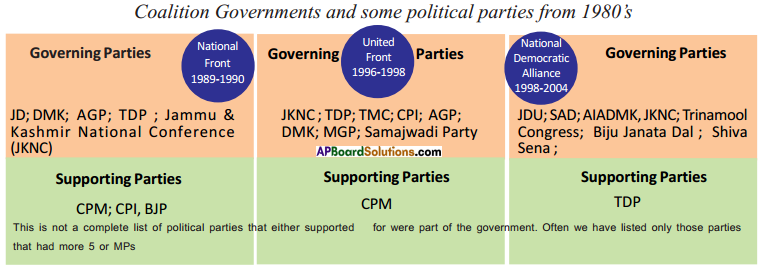
Now answer the following questions.
a) Which party was included in “Governing parties” in all the above coalition governments?
Answer:
Jammu & Kashmir National Conference (JKNC)
b) Which party gave support to NDA government?
Answer:
TDP.
c) Which party gave support to National Front and United Front from outside?
Answer:
CPM.
![]()
Question 22.
What did the emergence of competitive alternatives ensured?
Answer:
The emergence of competitive alternatives ensured that Indian voters could always exercise a reasonable choice. This also allowed many different political viewpoints and sectional interests to become active in state level and national politics.
Question 23.
How was the rule of the first non-Congress government?
Answer:
The Janata Party had come to power promising a restoration of democracy and freedom from authoritarian rule. However, the disunity among the partners had a serious effect on the governance and its rule is most often remembered for internal squabbles and defections. The factional struggle in the party soon culminated in the fall of the government within three years leading to fresh elections in 1980.
Question 24.
What happened whenever there was any political instability?
Answer:
Whenever there was any political instability or natural calamity in the neighbouring country, thousands of people moved into the State creating huge discomfort for the locals. The local people felt that they would lose their cultural roots and soon be outnumbered by the ‘outsiders’.
Question 25.
What was there besides culture and demographics?
Answer:
Besides culture and demographics, there was also an economic dimension. Trade and other establishments were in the hands of non-Assamese communities. The major resources of the State, including tea and oil were again not benefitting the locals.
Question 26.
What was the dominant thrust of the movement?
Answer:
The dominant thrust of the movement was that Assam was being treated as an “internal colony” and this had to stop. The main demands were that the local people should be given greater preference in employment, the “outsiders” should be removed and the resources should be used for the benefit of the locals.
Question 27.
Which has led to violent attempts of ethnic cleansing in Assam?
Answer:
Too much emphasis on ethnic identities had a negative impact on other communities of Assam like the Bodos, Khasis, Mizos and Karbis. Many of them too demanded autonomous status. They began to assert themselves and wanted to drive out people of other communities from their areas.
Question 28.
What did Punjab claim?
Answer:
It laid claims to the new capital city of Chandigarh which remained a union territory directly administered by the Centre. Punjab also claimed more water from Bhakra Nangal dam and greater recruitment of Sikhs in the army.
![]()
Question 29.
Write about the resolution of Akali Dal.
Answer:
The Akali Dal had passed a set of resolutions in 1978 during the Janata Party rule in the centre, calling upon the central government to implement them. Its most significant demand was to amend the Constitution to give more powers to the states and ensure greater decentralisation of powers.
Question 30.
What happened after Rajiv Gandhi’s entrance?
Answer:
After Rajiv Gandhi became the Prime Minister, he held talks with SAD and entered into an agreement with Sant Langowal, the SAD president. Though fresh elections were held in Punjab and SAD won them, the peace was short-lived as Langowal was assassinated by the militants.
Question 31.
What did Rajiv Gandhi say in his speech?
Answer:
In a famous speech Rajiv Gandhi said that out of every Rupee spent on the poor barely 15 paise reaches them I It highlighted the fact that despite huge increases in development expenditure, the story of the poor remained the same.
Question 32.
Which factors influenced the central government to use armed forces to reduce tensions in Assam?
Answer:
- Three factors influenced the use of armed forces in the Northeastern region.
- Firstly, it was a sensitive border area adjacent to China, Myanmar and Bangladesh.
- Secondly, rebel groups demanding separation from India, procured arms from outside.
- Thirdly, they indulged in large scale ethnic violence against minority communities.
- The government thought this was the only way to bring about peace in the area.
Question 33.
What was meant by liberalization?
Answer:
- It meant a lot of things put together like the drastic reduction of government expenditure, reducing restrictions and taxes on imports, etc.
- It proved for reducing restrictions on foreign investments in India and allowed foreign countries to set up companies in India.
- It is required to the opening of many sectors of the economy to private investors.
- It brought in foreign goods and Indian businessmen were forced to compete with them.
- It had many positive and negative impacts on India.
Question 34.
“One of the greatest weakness was undoubtedly the low priority given to primary education and public health”. Comment on it.
Answer:
- The post-Independence era is marked with less priority to education and health.
- The optimum development of country depends mostly on the education and health levels of the population of it.
- It further forms part of Human Development Indicators also.
- So, I suggest more priority should be given to education and health now.
Question 35.
Read the given information.
In 1992 government led by P.V. Narasimha Rao passed an important amendment to the Constitution to provide local self-governments a Constitutional Status. The 73rd Constitutional Amendment created institutions of local self government at the village level while the 74th Constitutional Amendment did the same in towns and cities. These were path-breaking amendments. They sought to usher in for the first time, office bearers at the local level elected on the basis of universal adult franchise. One-third of the seats were to be reserved for women. Seats were also reserved for scheduled castes and tribes.
Answer the following questions.
a) Which constitutional amendment created institution of local self-government?
b) According to which amendment general elections were conducted in towns and cities?
c) How many seats are reserved for women in local bodies?
Answer:
a) 73rd Constitutional Amendment created institutions of local self-governments for villages.
b) According to 74th Constitutional Amendment general elections were conducted in towns/cities.
c) 1/3 seats were reserved for women in local self-government elections.
Question 36.
“Do you think that the reservations will promote the social development” ? Express your ideas.
Answer:
- Reservations will definitely promote social development.
- Scheduled castes and tribes were drowtodden and suffered in the social stature for centuries.
- To develop themselves and to question the injustice they meted out, reservations will of great help.
- Reservations both in education, jobs, and legislature help them.
![]()
Question 37.
Imagine and write the main reasons for the continuation of anti Hindi movement in Tamil Nadu till today.
Answer:
- DMK in Tamil Nadu believed the passage of Official Languages Act, 1963 was an attempt to first Hindi on the rest of the country.
- They started a statewide campaign protesting the imposition of Hindi.
- They organised strikes, dharnas, burning effigies, Hindi books as well as pages of constitution.
- Still there is same feeling in Tamil Nadu.
Question 38.
“Some people think that Social Welfare Schemes do not reach eligible persons”. Express your suggestions.
Answer:
- Despite all the attention to development in the country, much of it did not reach the real beneficiaries.
- Despite huge increases in development expenditure the story of the poor remained the same.
- The main reasons were political and beaurocratic corruption.
- Enlistment of various beneficiaries also plagued by officialdom and political pressures.
Question 39.
“India needed to adapt itself to the new technologies emerging in the world, especially computer and telecommunication technologies”. Comment.
Answer:
- Technologies like computer and communication technology are thursting the world.
- It is believed that we should also adopt them without fail.
- With initiatives of Rajiv Gandhi now called ‘Telecom Revolution1 was introduced in India.
- With the help of satellite technology communications spread widely and extensively.
- Everyone has access to mobile phones, the internet, email, facebook, Twitter, etc.
10th Class Social 19th Lesson Emerging Political Trends 1977 to 2000 4 Marks Important Questions and Answers
Question 1.
Read the text given and answer the questions.
Panchayati Raj & 73rd, 74th Amendment
In 1992, Government led by P.V. Narasimha Rao passed an Important amendment to the Constitution to provide Local Self Governments a Constitutional status. The 73rd Constitutional Amendment created Institutions of local self-government at the village level, while the 74th Constitutional Amendment did the same in towns and cities. These were pathbreaking amendments. They sought to usher in for the first time, office bearers at the local level elected on the basis of Universal Adult Franchise. One-third of the seats were to be reserved for women. Seats were also reserved for scheduled castes and tribes. The concerns of the State governments were taken into account and it was left to the States to decide on what functions and powers were to be developed to their respective local self-governments. Consequently, the powers of local self-governments vary across the country.
i) What is Local Self Government?
Answer:
The Government that formed by the people at the village, town and city level to solve the local needs is Local Self Government.
ii) Which government recognised the Constitutional status of Local self Government?
Answer:
P.V. Narasimha Rao or Congress Government.
iii) What does the 73rd Constitutional Amendment say?
Answer:
Creation of Local Self government at the village level.
iv) 1/3 of seats were to be reserved for women in Local Self Governments. Comment.
Answer:
Women need political equality and they should Involve actively In the Local Governments.
![]()
Question 2.
Read the following paragraph and answer the given questions.
Liberalization measures brought in foreign goods and forced Indian business to compete with global manufacturers. It also led to the setting up of industries and business by foreign companies in India. However, it also meant a lot of hardship for the common people as the government was forced to cut subsidies to the people and as many factories closed down due to Influx of cheap foreign goods. This also led to privatization of many public amenities tike education, health, and transport and people had to pay high prices to private service providers.
Write your opinion on the consequences of liberalization.
(OR)
What are the consequences of economic Liberalization?
Answer:
- India was drawn into the world market.
- Liberalization paved the way to telecom revolution.
- Liberalization forced Indian business to compete with global manufactures.
- The government was forced to cut subsidies which results a great loss to people and local industries.
- It also led to the privatization of many public amenities like education, health and transport.
- It led to globalization.
- The policies of liberalisation have been of advantage particularly to well of sections only.
Question 3.
Explain the importance of regional parties in Democracy.
Answer:
- Multi-party system which includes national parties and regional parties strengthens the democracy.
- Regional parties reflect the spirit of the federalism.
- Regional parties have good understanding of the problems and needs of the respective states.
- They focus mainly on the development of their states.
Question 4.
Telecom revolution has brought several changes in human life nowadays. Explain them.
Answer:
Changes brought by the telecom revolution:
- Saves time
- Fast communication
- Online services
- Prosperous life
- Addiction
- Obesity
- Cost of living increased
- Affected human relations
Question 5.
Read the paragraph given below and interpret.
India was forced to open up and ‘liberalise’ its economy by allowing free flow of foreign capital and goods Into India. On the other hand, new social groups asserted themselves politically for the first time, and finally, religious nationalism and communal political mobilisation became Important features of our political life. All this put the Indian society into great turmoil, we are still coming to grips with these changes and adapting ourselves to them.
Answer:
- Liberalisation means relaxation of previous government restrictions usually in areas of social and economic policy.
- The twentieth century ended with India’s drawing into the world free market.
- India was forced to open up and liberalise its economy. It allowed free flow of foreign capital and goods into India.
- On the other hand, India seemed to have a thriving democracy in which voices of different sections of the population were making themselves heard and in which divisive and communal political mobilisation was threatening to destroy social peace.
- It had stood the test of time for over fifty years and had built a relatively stable economy and deeply rooted democratic politics.
- It still had not managed to solve the problem of acute poverty and gross inequality between castes, communities, regions and gender.
Question 6.
Observe the following table and write a paragraph analyzing it.
Summary of the 2014 -Indian General Elections
| Party | Alliance | Votes(%) | Seats |
| BJP | NDA | 31% | 282 |
| INC | UPA | 19.31% | 44 |
Answer:
The given table describes the summary of the 2014 general elections in India. In the given table two parties that is Bharatiya Janata Party and the Indian National Congress are compared. It is not only the party comparison but their alliances are also mentioned. The Bharatiya Janata Party alliance is National Democratic Alliance whereas the United Progressive Alliance is related to Indian National Congress. In these elections the NDAgot 31% of the votes whereas the UPAgot 19.31%. If we observe the seats, the BJP with its alliance won 282 whereas the INC won only 44. These elections are very crucial because the voter strongly rejected the pre-independence party which ruled India since 1947. For a long time it was a single largest party to win the seats in Lok sabha. The voters cleverly gave mandate to the Bharatiya Janata Party with the hopes that their future may be changed. The BJP announced the Prime Ministerial candidate, Narendra Modi in advance. He achieved and succeeded in Gujarat as Chief Minister. So the voters accepted him as Prime Minister also. They believed him. Congress lost faith of the people because of its failures. During Congress period there was a lot of corruption, scams and nepotism, etc. Many of the Congress members of Parliament were in court cases. Rajiv Gandhi himself declared that corruption is highly established in India. If the Bharatiya Janata Party with its alliance work for the development of the country, definitely they will win the next coming 2019 elections. So the party should keep this in mind and work in that direction.
![]()
Question 7.
Explain the effects along with the reasons for the emerging era of coalition politics.
Answer:
Reasons for the emergence of coalition era of politcs:
- Multi party system
- No single party securing required majority.
- Significance of regional parties increased.
- Congress party gradually lost people’s mandate after 1960s.
Effects:
- No political stability
- Isolating the ideologies
- Giving importance to party’s interest at the cost of nation’s interest.
- Coming to power in spite of securing less mandate.
Question 8.
Read the following paragraph and write your opinion.
The twentieth century closed with India which was drawn into the world market, India which seemed to have a thriving democracy in which voices of different sections of the population were making themselves heard and in which, divisive and communal political mobilisation were threatening to destroy social peace. It had stood the test of time for over fifty years and had built a relatively stable economy and deeply rooted democratic politics. It still had not managed to solve the problem of acute poverty and gross inequality between castes, communities, regions and gender.
Answer:
The given paragraph depicts about divisive and communal politics. These may destroy the social peace. After independence in India, stable government continued for 30, 40 years and unstability began. Main problem of solving poverty and inequalities with regard to caste, region is not yet solved.
My opinion is that the politics are only vote bank based. Sometimes the political leaders are there behind the communal riots. To throw out some Chief Minister of the same party, their party leaders encourage these riots. Caste based politics are shown at the time of tickets given to party candidates. Caste unions, and the caste group heads are distributed money to lure them to get their votes. Some constituencies are fixed for some religion because of their dominance in number. It is really a threat to democracy. Holy places of worship are also in some cases used to spread communal message. That destroys social peace.
My suggestion is that people should get awarness about this and act accordingly.
Question 9.
Observe the following table and analyse it.
The trend of Coalition Governments, 1989 – 2004
| S.No. | Coalition | Duration | Governing parties | Supporting parties |
| 1. | National Front | 1989 – 90 | JD, DMK, AGP, TDP, JKNC | CPM, CPI, BJP |
| 2. | United Front | 1996 – 98 | JKNC, TDP, TMC, CPI, AGP, DMK, MGP | CMP |
| 3. | National Democratic Alliance | 1998 – 2004 | JDU, SAD, TMC, AIADMK, JKNC, BJD, Shiva-Sena | TDP |
Answer:
- The given table is about the trend of Coalition Governments during the period of the years from 1989 to 2004.
- The details of three coalition governments and their duration, etc. are given in the table.
- During 1989-1990 Janata Dal-led National Front formed the government. The governing parties in this government were JD, DMK, AGP, TDP, JKNC. CPM, CPI and BJP supported this government.
- United Front formed the coalition government during 1996-1998. JKNC, TDP, TMC, CPI, AGP, DMK, MGP were the governing parties in this government. CPM supported this government.
- During 1998-2004 BJP-led National Democratic Alliance formed the government. The governing parties in this government were JDU, SAD, AIADMK, JKNC, TMC, BJD and Shiva Sena. TDP rendered support to the NDA government.
- The 1990s were years of very significant change in the post-Independence India.
- With the transformation to a competitive multi-party system, it became near impossible for any single party to win a majority of seats and form a government of its own.
- Since 1989, all governments that had formed at the national level have been either coalition or minority governments.
![]()
Question 10.
Explain about Assam movement in detail.
Answer:
Assam movement:
It is the struggle between Assamese and non-Assamese. These non-Assamese were none other than the people of Bangladesh. The youth of Assam formed All Assam Students Union (AASU) and was in the forefront of agitation. It led a number of strikes, agitations and marches to remove the so called outsiders. The problem of outsiders is not a cultural one but of economic issue. Every country or state wants to protect their cultural roots. The Assamese were most of them, Hindus and the outsiders were Muslims. The local people were afraid of their cultural roots.
Now they affect the trade and so the livelihoods of the locals had been in trouble. It is not only the problem of Assam, it happens at many states. Outsiders dominate a few areas of business and so the locals lose opportunities. In Assam the locals were not given priority or preference in employment. This was the demand of the Assamese. Gradually these demands led to communal polarisation as most of the outsiders are from Bangladesh Muslims. The movement between the Assamese and outsider Muslim led to form an idea of anti Indian stand.
Central Government took initiation and went on for talks for three years. An agreement was signed by the central government and the students union. In the next elections Assam Gana Parishad (an offshoot of AASU) came to power.
In conclusion, the formation of Bangladesh erstwhile Pakistan was taken place on the basis of religion. One’s religion can be given respect by all but it led to many disturbances. The Muslims, the outsiders of Assam occupied most of the areas of trade and business and there was distress and disappointment among the Assamese. The outsiders would have settled in Bangladesh only. They wanted their country to be separated and still they are coming to India illegally. Recently both the Prime Ministers of India and Bangladesh sat together and solved a few problems. If any problem arises, they should sit together and problems can be solved.
Question 11.
Prepare an album by collecting the photos of Prime Ministers of India and write their specialities.
Answer:

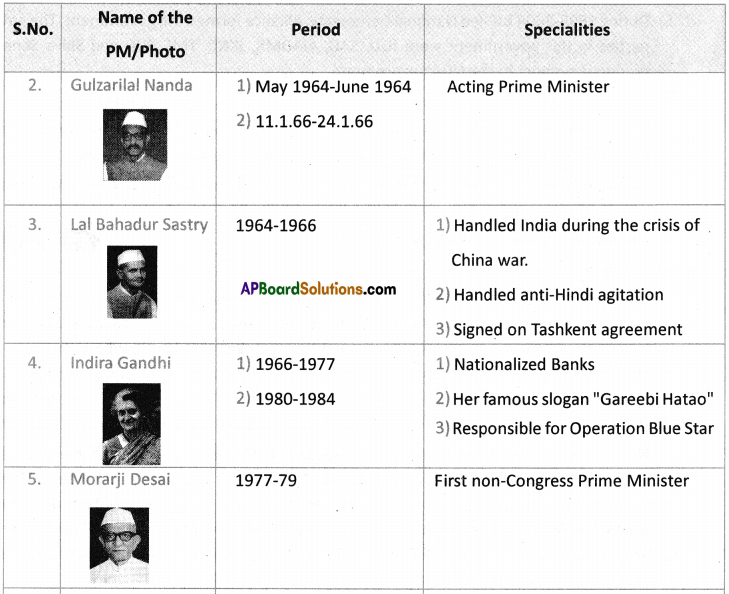
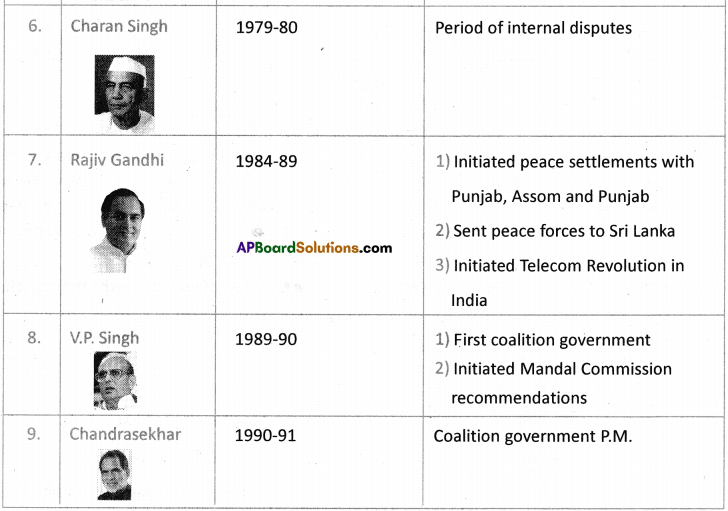
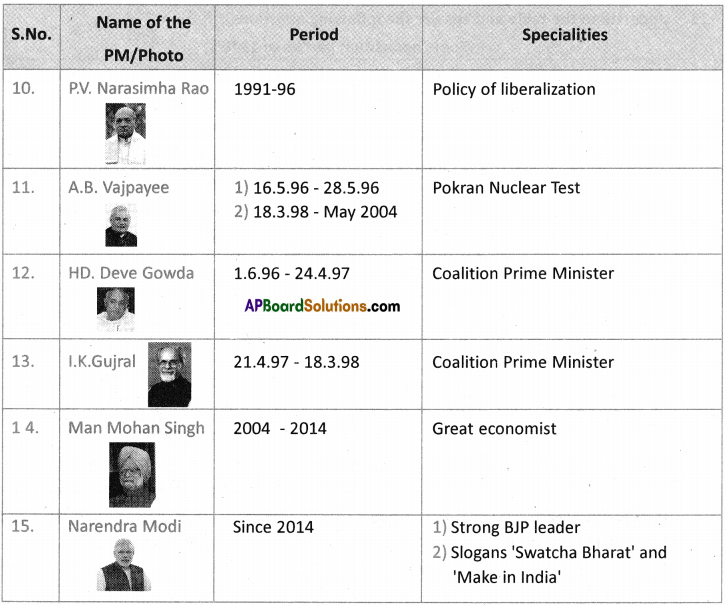
Question 12.
You may notice how simple and genuine demands of the people of Punjab were hijacked by religious and anti-national extremists. What steps do you think would have prevented this?
Answer:
- The simple and genuine demands of Punjab were
a) the contribution of state was ignored
b) received unfair bargain when it was created
c) capital remain UT
d) more water from Bhakra Nangal and
e) greater recruitment of Sikhs in the army. - Akali Dal government was dismissed by Congress.
- A series of untoward incidents increased distance between Sikhs and the central government.
- Militant Sikhs demanded separate state.
- They occupied Golden Temple, then Congress used army to vacate.
- A fallout led to the assassination of Indira.
- Rioting in Delhi against Sikhs was followed.
- Later Langowal made an agreement with centre but was killed by militants.
- Militants engaged in extortion and kidnapping and lost faith of the people
![]()
Question 13.
Understand the table and answer the following questions.
Some opposition parties of 1970’s
| SI.No. | Name of the party | Place of Activity | Ideologies |
| 1. | BLD-Bharatiya Lok Dal | Uttar Pradesh | Special attention to Indian farmers |
| 2. | Congress (O) | Entire India | Conservative section opposed policies of Indira Gandhi |
| 3. | CPI (M) Communist Party of India (Marxist) |
West Bengal, Tripura, Kerala, and remained states | Radical land reforms, trade unionism, socialist policies |
| 4. | DMK – Dravida Munnetra Kazagam | Tamil Nadu | 1. Greater autonomy and powers to state 2. Fiercely opposed Hindi in the state |
| 5. | Jan Sangh | Northern States | A Hindu nationalist party |
| 6. | SAD – Shiromani Akali Dal | Punjab | 1. Great autonomy to states 2. Organised around Gurudwaras |
a) Which political party fiercely opposes Hindi in the state ?
Answer:
DMK is the party which opposes Hindi in the state.
b) What is the place of activity for Jan Sangh?
Answer:
Jan Sangh is active in Northern States.
c) What is the ideology of CPI (M)?
Answer:
The ideologies of CPI (M) are radical land reforms, trade unionism and socialist policies.
d) Where is the political party which shows special attention to farmers, active ?
Answer:
The political party, which shows special attention to farmers is active in Uttar Pradesh.
e) Which party is of semireligious nature?
Answer:
SAD – Shiromani Akali Dal is of semireligious nature.
Question 14.
What were the implications of 1977 general elections?
Answer:
- It was a historical election for democracy.
- The Congress party was defeated at the national level for the first time.
- Janata Party became victorious and tried to consolidate itself.
- It dismissed nine Congress governments in states.
- It argued that Congress had lost its mandate to rule in the states as it had been defeated.
- Its stand somewhat proved correct by the results.
- Except Tamil Nadu and West Bengal, Janata Party came to power in states.
- The disunity among the partners had a serious effect on governance.
- The government fell within three years.
- It led to fresh elections in 1980.
Question 15.
Why was the public sympathy to Punjab militant Sikhs declined?
Answer:
- They formed armed attachments and engaged in terrorist activities.
- They clashed with police and other religious groups.
- Those who were not confirmed to militant approved behaviour were killed.
- There were civil casualities in derailing trains, exploding bombs, etc.
- They were engaged in kidnapping, extortion to raise funds.
- All this gradually alienated them from masses and even Sikhs.
- Over a period, public sympathy declined rapidly.
- Peace was finally returned to Punjab by the end of 1990s.
![]()
Question 16.
‘Coalition governments induce political instability’ – Elucidate.
Answer:
- Since 1989, all governments at national level were coalition/minority governments.
- A number of national and regional parties had come together.
- So political ideologies and programmes of all parties had to be accommodated.
- A common agreement had to be arrived at.
- No party could pursue extreme agendas.
- They needed to tone down their approaches.
- It caused considerable instability.
- Many coalitions did not last their full time.
Question 17.
How do political parties reap on communal polarisation? Provide an example.
Answer:
- The Hindus are led by Bharatiya Janata Party.
- In the year 1984 LokSabha elections they won only 2 seats.
- It made great strides when it took up the Ayodhya issue.
- It decided to campaign for the building of a temple at the site of mosque.
- It claimed that was the birthplace of Lord Rama.
- L.K. Advani in 1990, led a ‘Rath Yatra’ from Somanath to Ayodhya.
- This campaign was accompanied by intense communal polarisation.
- It caused a large number of communal conflicts.
- In 1991 General elections BJP’s strength went up to 120.
- It was then Rajiv was killed and sympathy wave followed the Congress, still, BJP withstood it.
Question 18.
What is meant by liberalisation?
Answer:
- It means a lot of things put together.
- It proposes drastic reduction of government expenditure.
- It asks for reducing restrictions and taxes on import of foreign goods.
- It provides for reducing restrictions on foreign investments in India.
- It is required to the opening of many sectors of the economy to private investors.
- It brought in foreign goods and forced Indian business to compete with them.
- It allowed foreign countries to set up companies in India.
- Common people suffered with cut of subsidies.
- Many factories were closed down due to influx of cheap foreign goods.
![]()
Question 19.
Study the timeline given below and answer the following questions.
 a) Who was the Prime Minister that initiated peace agreements with Sri Lanka?
a) Who was the Prime Minister that initiated peace agreements with Sri Lanka?
Answer:
Rajiv Gandhi initiated peace agreements with Sri Lanka.
b) Which government tried to implement Mandal Commissions report?
Answer:
Janata Dal government tried to implement Mandal Commissions report.
c) Name two important incidents occurred during the period of P.V. Narasimha Rao.
Answer:
Economic liberalization and the demolition of the Babri Masjid took place during the period of P.V. Narasimha Rao.
d) When was Indira Gandhi assassinated?
Answer:
Indira Gandhi was assassinated in 1984.
e) Who were the Prime Ministers of National Front Government?
Answer:
Deve Gowda and I.K. Gujral were the Prime Ministers of the National Front Government.
f) Who were the Prime Ministers of Janata Dal Government?
Answer:
V.P. Singh and Chandrasekhar were the Prime Ministers of Janata Dal Government.
g) Who led the Congress party after the assassination of Rajiv Gandhi?
Answer:
P.V. Narasimha Rao led the Congress party after the assassination of Rajiv Gandhi.
h) Who led the NDA government?
Answer:
A.B. Vajpayee led the NDA government.
i) When was the NDA Government formed?
Answer:
NDA formed the government in 1998.
Question 20.
Read the following information and answer the questions.
Some opposition parties of 1970s
BLD – Bharatiya Lok Dal – A party which was formed of socialists who called for special attention to Indian farmers, based mainly in Uttar Pradesh.
Congress (O) – The conservative section of the Congress which had opposed the policies of Indira Gandhi.
CPI (M) – Communist Party of India (Marxist)-a party with a national presence, which strove for radical land reforms, trade unionism and socialist policies.
DMK – Dravida Munnetra Kazagam – a party based mainly in Tamil Nadu which sought greater autonomy and powers for the state.
Jan Sangh – A Hindu nationalist party largely confined to the northern States.
SAD – Shiromani Akali Dal – a party based in Punjab catering specially to the Sikhs and organised around Gurudwaras. It therefore had a semi-religious character. It was also in favour of greater autonomy to the States.
a) Which party fought for autonomy in Tamil Nadu?
Answer:
Dravida Munnetra Kazagam fought for greater autonomy in Tamil Nadu.
b) Which party showed special attention to Indian farmers mainly in UP?
Answer:
Bharatiya Lok Dal showed special attention to farmers mainly in U.P.
c) Name the regional party of Punjab.
Answer:
Shiromani Akali Dal is the regional party of Punjab.
d) Name one Hindu nationalist party.
Answer:
“Jan Sangh” is one Hindu nationalistic party.
e) Which opposed the policies of Indira Gandhi?
Answer:
Congress (O) – The conservative section of the Congress opposed the policies of Indira Gandhi.
f) What was the main aim of SAD?
Answer:
It sought for greater autonomy to Punjab.
g) Which party was confined to North India only?
Answer:
Jan Sangh was confined to North India only.
![]()
Question 21.
Read the following passage and interpret it.
Panchayati Raj & 73rd, 74th amendment
In 1992 government led by P.V. Narasimha Rao passed an important amendment to the Constitution to provide local self-governments a Constitutional Status. The 73rd Constitutional Amendment created institutions of local self government at the village level while the 74th Constitutional Amendment did the same in towns and cities. These were path-breaking amendments. They sought to usher in for the first time, office bearers at the local level elected on the basis of universal adult franchise.
One-third of the seats were to be reserved for women. Seats were also reserved for , scheduled castes and tribes. The concerns of the State governments were taken into j account and it was left to the States to decide on what functions and powers were to be devolved to their respective local self governments. Consequently, the powers of local self governments vary across the country.
Answer:
- In 1992 P.V. Narasimha Rao s government passed the important amendments of 73rd and 74th.
- The 73rd amendment created institutions of local self governments at the village levels.
- The 74th amendment created institutions of local self-governments at the town and city levels.
- They are path-breaking as the office bearers at the local level are elected on the basis of universal adult franchise.
- Seats are reserved for women and Scheduled Castes and Tribes too.
- Powers were devolved to their respective local self-governments.
- Hence we can say that these two amendments were path-breaking.
Question 22.
On the outline map of India locate the On the outline map of India locate the following.
- Andhra Pradesh
- Assom
- Punjab
- Tamil Nadu
- West Bengal
- Uttar Pradesh
- Nagaland
- Mizoram
- Bihar
- Gujarat
- Maharashtra
- Ayodhya
Answer:

![]()
Question 23.
Locate the following in the given map of World.
- Madagascar Island
- Nigeria
- Holland
- Amsterdam
- Brazil
- Jordan
- Israel
- Spain
- Palestine
- Bangladesh
Answer:

![]()

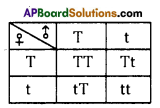





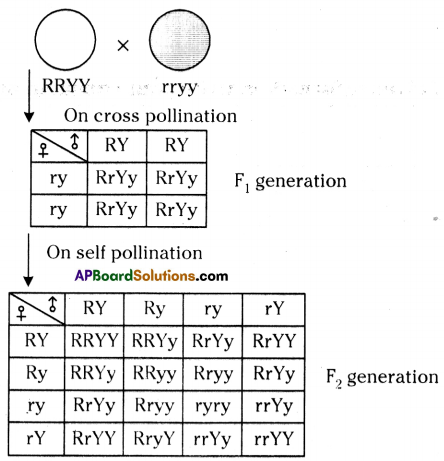
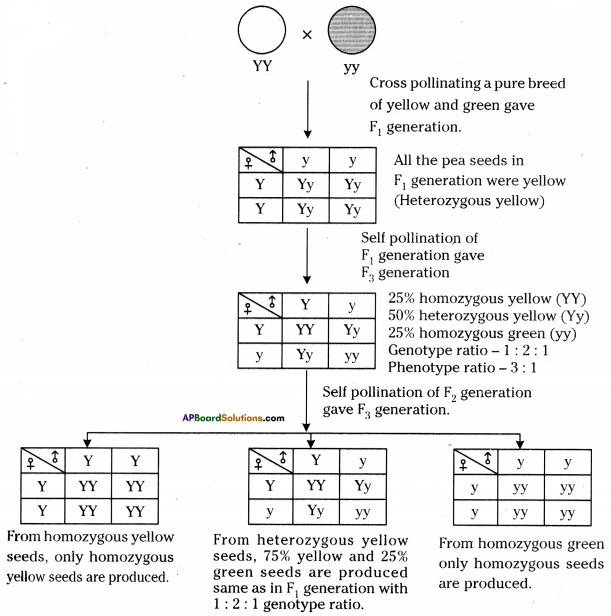
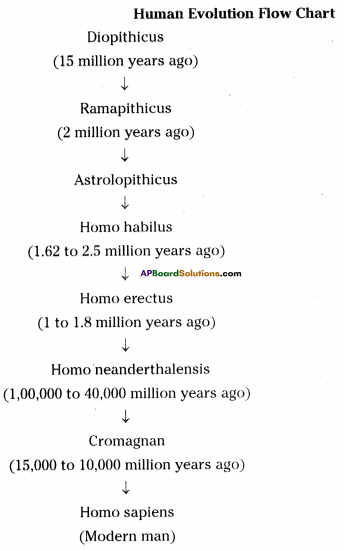


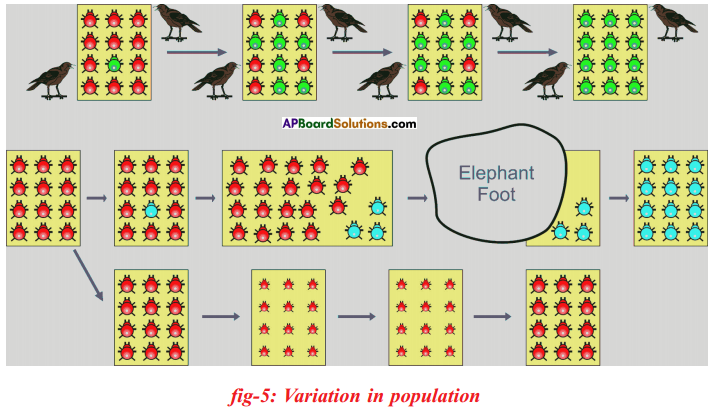 Let us consider a group of twelve beetles. They live in bushes on green leaves. Their population will grow by sexual reproduction. So they were able to generate variations in population. Let us assume crows eat these red beetles. If the crows eat more Red beetles, their population is slowly reduced. Let us discuss the above three different situations in detail.
Let us consider a group of twelve beetles. They live in bushes on green leaves. Their population will grow by sexual reproduction. So they were able to generate variations in population. Let us assume crows eat these red beetles. If the crows eat more Red beetles, their population is slowly reduced. Let us discuss the above three different situations in detail. Moreover, this green coloured beetle passes its colour to Its offspring (Progeny). So that all its progeny are green. Crows cannot see the green coloured beetles on green leaves of the bushes and therefore crows cannot eat them. But crows can see the red beetles and eat them. As a result there are more and more green beetles than red ones which decrease in their number.
Moreover, this green coloured beetle passes its colour to Its offspring (Progeny). So that all its progeny are green. Crows cannot see the green coloured beetles on green leaves of the bushes and therefore crows cannot eat them. But crows can see the red beetles and eat them. As a result there are more and more green beetles than red ones which decrease in their number. Crows can see blue coloured beetles on the green leaves of the bushes and the red ones as well. And therefore crows can eat both red and blue coloured beetles. In this case there is no survival advantage for blue coloured beetles as we have seen in case of green coloured beetles.
Crows can see blue coloured beetles on the green leaves of the bushes and the red ones as well. And therefore crows can eat both red and blue coloured beetles. In this case there is no survival advantage for blue coloured beetles as we have seen in case of green coloured beetles. So beetles are poorly nourished. So the weight of beetles decrease but no changes take place in their genetic material (DNA). After a few years the plant disease are eliminated. Bushes are healthy with plenty of leaves.
So beetles are poorly nourished. So the weight of beetles decrease but no changes take place in their genetic material (DNA). After a few years the plant disease are eliminated. Bushes are healthy with plenty of leaves.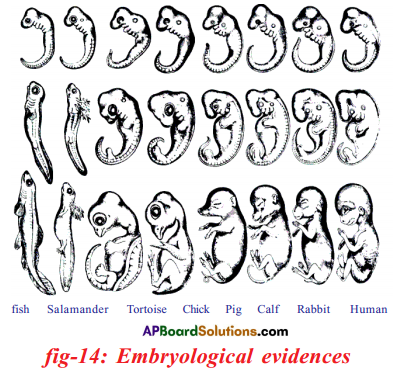
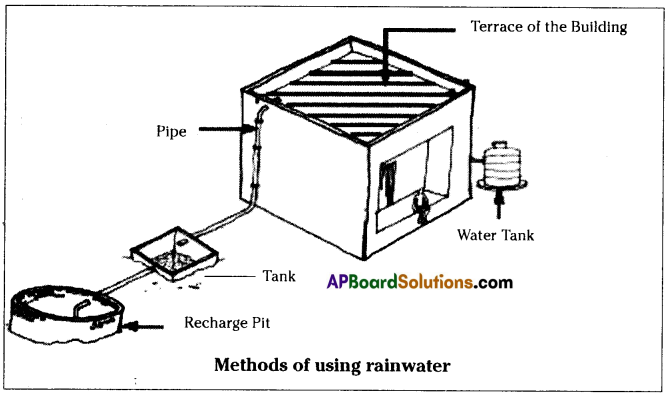
 i) No, the production of oil doesn’t meet the consumption in India.
i) No, the production of oil doesn’t meet the consumption in India. In which state, Indira Sagar Project is located and on which river?
In which state, Indira Sagar Project is located and on which river?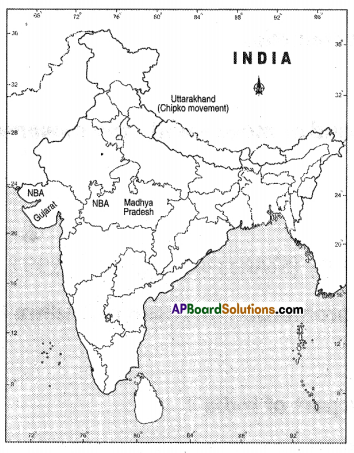

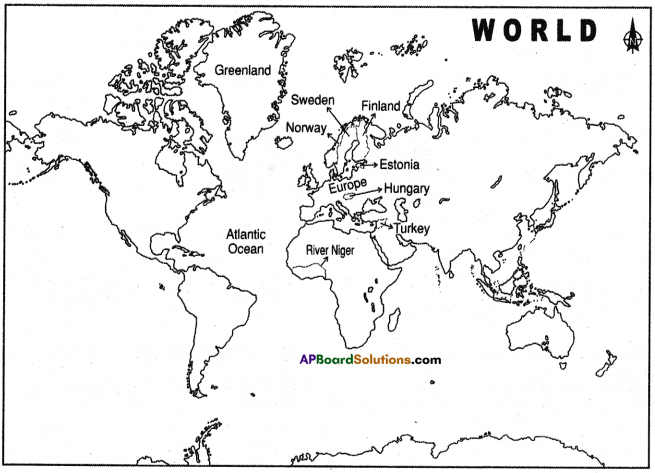
 Answer:
Answer:
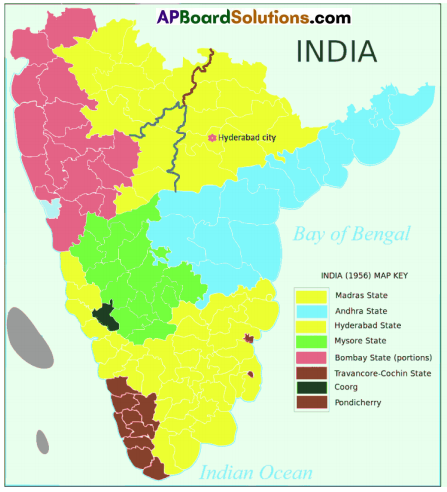
 1. Which political party secured less seats ?
1. Which political party secured less seats ?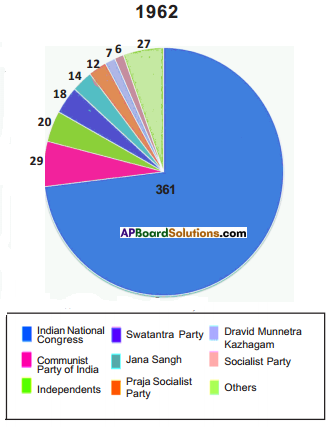
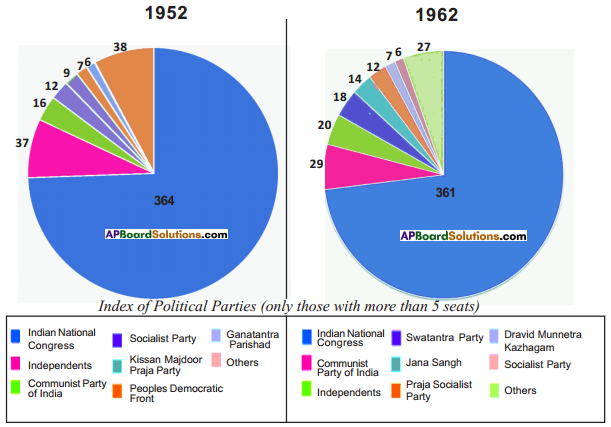 Compare the above Pie diagrams.
Compare the above Pie diagrams.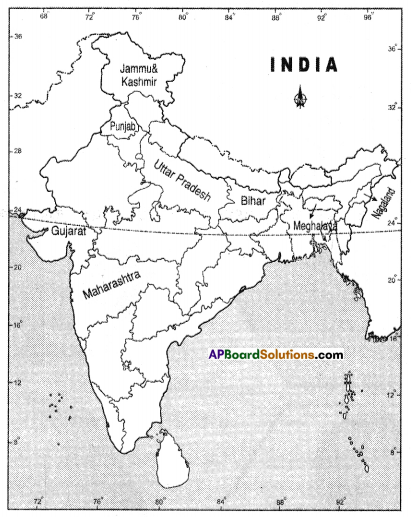
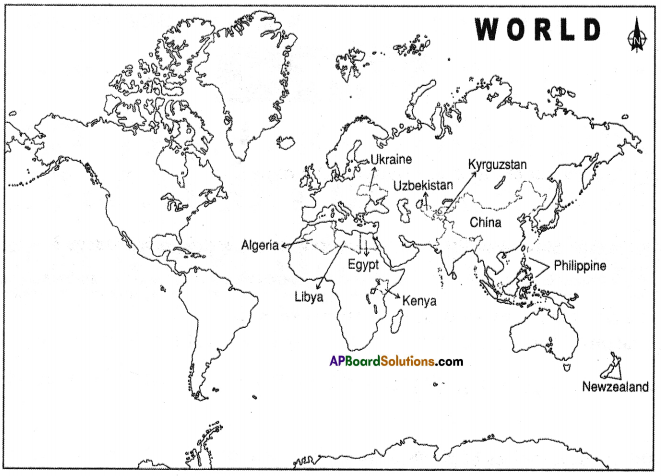

 Role of different sets of teeth in mastication:
Role of different sets of teeth in mastication: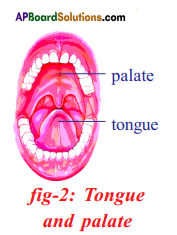

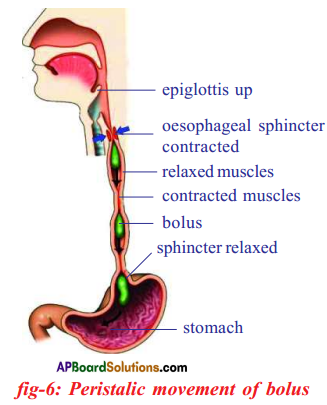 Importance of mucus on the walls of food pipe :
Importance of mucus on the walls of food pipe : Coordination of digestive system with circulatory system :
Coordination of digestive system with circulatory system :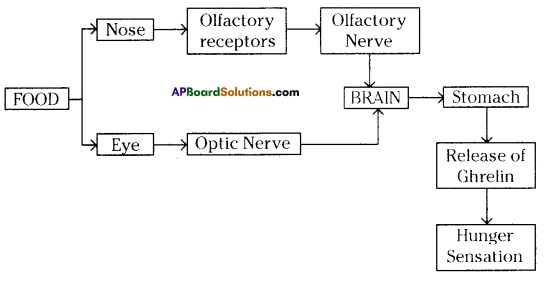

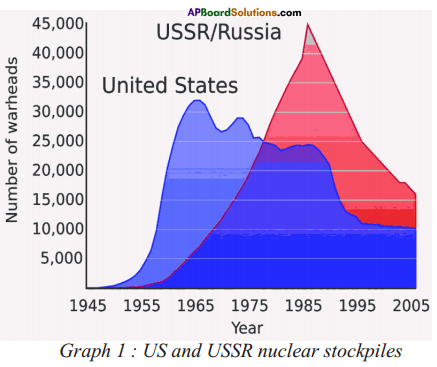 a) During 1955-2005, which country had the highest number of warheads?
a) During 1955-2005, which country had the highest number of warheads?
 A) Write any two countries which are sharing boundary with India on the North-eastern side.
A) Write any two countries which are sharing boundary with India on the North-eastern side.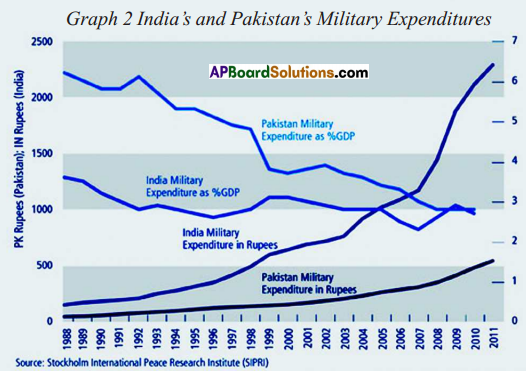 1. Which country had spent more on Military Expenditure in its GDP?
1. Which country had spent more on Military Expenditure in its GDP?

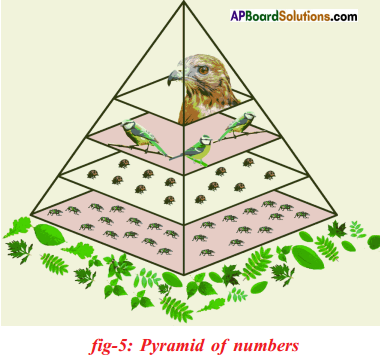
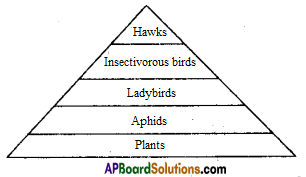
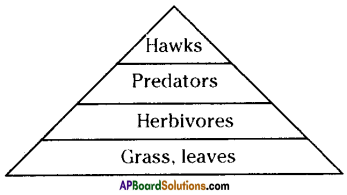

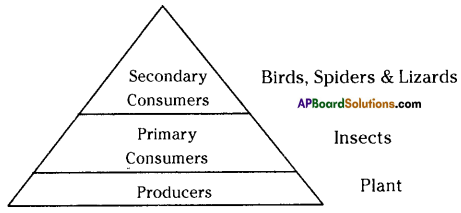
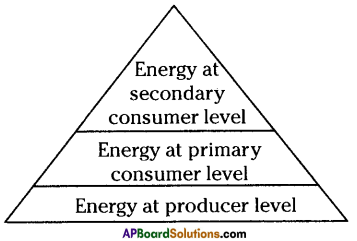
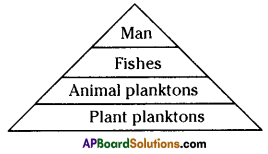
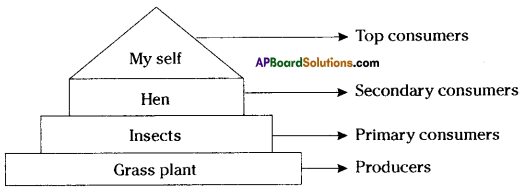

 Legend:
Legend:


